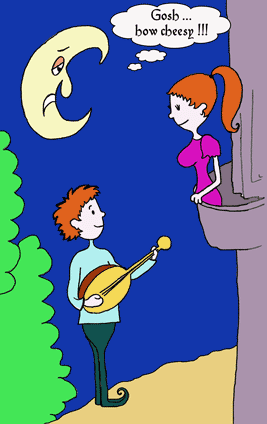Learning: What's love got to do with it?

It was the nightingale, and not the lark,
That pierced the fearful hollow of thine ear;
Nightly she sings on yon pomegranate-tree:
Believe me, love, it was the nightingale.
Do these lines sound familiar to you?
When I was in highschool I had a horrible crush on a girl called Laura. I wanted to date her somehow, but somehow she seemed so incredibly aloof. One day a friend of mine had an idea. He was quite active in the theater club, and he knew that Laura was participating as well. Thus, he suggested that I should join also, so that I could get to know Laura. Actually, I wasn't interested at all in Shakespeare and all that stuff. To be honest, the hatred between the Montagues and the Capulets was nothing compared to mine towards our English literature classes, reading and memorizing texts. But no obstacle is too big when it comes to love, right? So I just gave it a try and guess what: Though I didn't manage to win Laura's heart, Shakespeare won mine! I actually started to like his works and even improved my grades in my English class! How was that possible?
I had almost forgotten this learning experience until I started to study Chemistry at the university, realizing that I had an easier time memorizing things I learned during lab work than during lectures. I talked to a professor of mine about this observation. He told me that there is a didactic framework called constructivism that might explain my observation.
Constructivism views learning as an individual and interactive process during which the learner builds new concepts and ideas. The learner's motivation and responsibility for learning play an important role according to the constructivist approach. Furthermore, the teacher is considered an encouraging facilitator. In short: constructivist teaching strategies focus a lot on learning by doing. Numerous studies show that learning by doing can be highly effective.

M.T.H. Chi, M. Bassok, M. W. Lewis, P. Reimann, R. Glaser (1989)
Self-explanations: How students study and use examples in learning to solve problems.
Cognitive Science, 13, 145-182
You can even apply constructivist teaching strategies to e-learning. For example, at the IADIS e-learning conference in Amsterdam 2008, a group of Japanese English teachers for example presented a new way of learning business English at the University of Tokushima: Niche Learning. In this method students create their own learning material by selecting topics, organizing information, writing skripts and playing small video sketches, which are then discussed in the classroom. The production of the sample videos is an extracurricular activity with the teacher playing the role of a facilititator. Thus, the students' learning efficiency increases, because they feel responsible for their own material. They actually "live" the learning content by playing it and get socially involved with their fellow students and their teacher. And if someone has a crush on a classmate who also works on the project: even better! What can be more motivating than love?
|
MemoryLifter is available for free. The success of this freeware depends on whether people recommend it to others. Please forward this newsletter or tell a friend.

